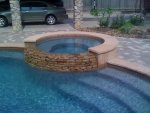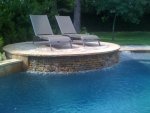I have asked a few questions lately regarding PH rise and TA, but I'm still having a problem, so I thought I would create a new topic to try to get some help.
My problem is that my PH has started to rise rapidly and I need to get it stabilized. My current numbers are as follows:
FC - 5
CC - .5
PH 7.8
TA - 90
CH - 270
CYA - 50
Temp - 92
You might think that a PH of 7.8 doesn't sound to bad, except thats what it was this morning and I added 3 cups of Muriatic acid before work. I got home this afternoon and its already back up to 7.8.
I've been trying to reduce my TA down to 60 per advice on this site. I started at 100 about 4 days ago and thought I had gotten it down to 80. However, when I checked this afternoon, it was back up to 90. I'm being very careful doing the TA test and trying to get even drops every time. I feel pretty confident about the test number.
A couple of factors that I think may be contributing to the problem:
1. The Pool was completed late January (Pebblesheen surface) so its relatively new.
2. I've got a raised spa that spills over most of the day and a waterfall that runs periodically (See pics below)
3. TA is probably still too high based on my level of Aeration
4. Its been extremely hot in Texas and I've been topping off the pool every 2 days. Fill water TA is 110.
5. When I was still using Trichlor pucks, PH was holding fairly steady
I still don't think I really understand how TA helps buffer PH. One question I have is if I am only adding bleach, how can the TA be rising. My understanding was that to lower, TA, I need to lower PH to 7.0-7.2 and then aerate to raise PH back to normal levels without raising TA. I don't think aeration is the problem. In my case, when I do this, PH is back to 7.8 by the end of the day. I just got through adding another 50oz of Muriatic acid to drop the PH back down to around 7.0.
Am I on the right track or could something else be contributing to the rapid rise in PH.
[attachment=1:2p029v9n]Spa Overflow.JPG[/attachment:2p029v9n]
[attachment=0:2p029v9n]Waterfall Deck.JPG[/attachment:2p029v9n]
My problem is that my PH has started to rise rapidly and I need to get it stabilized. My current numbers are as follows:
FC - 5
CC - .5
PH 7.8
TA - 90
CH - 270
CYA - 50
Temp - 92
You might think that a PH of 7.8 doesn't sound to bad, except thats what it was this morning and I added 3 cups of Muriatic acid before work. I got home this afternoon and its already back up to 7.8.
I've been trying to reduce my TA down to 60 per advice on this site. I started at 100 about 4 days ago and thought I had gotten it down to 80. However, when I checked this afternoon, it was back up to 90. I'm being very careful doing the TA test and trying to get even drops every time. I feel pretty confident about the test number.
A couple of factors that I think may be contributing to the problem:
1. The Pool was completed late January (Pebblesheen surface) so its relatively new.
2. I've got a raised spa that spills over most of the day and a waterfall that runs periodically (See pics below)
3. TA is probably still too high based on my level of Aeration
4. Its been extremely hot in Texas and I've been topping off the pool every 2 days. Fill water TA is 110.
5. When I was still using Trichlor pucks, PH was holding fairly steady
I still don't think I really understand how TA helps buffer PH. One question I have is if I am only adding bleach, how can the TA be rising. My understanding was that to lower, TA, I need to lower PH to 7.0-7.2 and then aerate to raise PH back to normal levels without raising TA. I don't think aeration is the problem. In my case, when I do this, PH is back to 7.8 by the end of the day. I just got through adding another 50oz of Muriatic acid to drop the PH back down to around 7.0.
Am I on the right track or could something else be contributing to the rapid rise in PH.
[attachment=1:2p029v9n]Spa Overflow.JPG[/attachment:2p029v9n]
[attachment=0:2p029v9n]Waterfall Deck.JPG[/attachment:2p029v9n]



